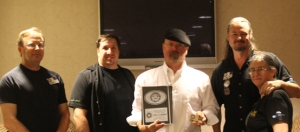Log and diary keeping has been a popular way of expressing oneself for centuries. So with the advent of the internet, it only made sense to start posting logs there as well. What no one could have fathomed was the explosion of popularity in reading other people’s thoughts online. It has become an industry of its own. News, web magazines, product reviews; some companies will even pay someone for advertising space just because the blog is popular and sees a lot of traffic. Far removed from simply an online journal, nowadays can cover any and every topic. Of course, because anyone can post a blog for anything, content can range anywhere from the thought provoking and professional to the frivolous and stupid. Because there are no editors, it is up to the blog writer to maintain the quality of the blog. And as these popular blogs will show, this ‘no rules,’ approach does not lend itself equally well to everything a blog can be used for.
The blog Girl’s Gone Child was started by Rebecca Woolf in 2005. It is a classic online-diary type of blog, centered on the occurrences of everyday family life, and written for the enjoyment—or as for—mothers. Originally, it centered on what she was going through when she first became a mother, and the troubles she was having just keeping her family together. One saved marriage and three more children, it has evolved into a sort of slice of life chronicle, dedicated to daily musings, photos of Mrs. Woolf and her family, recipes, and other uplifting works for fellow mothers.
Because it has been ongoing since 2005, Girls Gone Child has become rather stuffed with content, and feels bloated in places. This is most obvious on the homepage, which stretches down for many, many pages, and holds all Mrs. Woolf’s posts for the last week. Not simply a banner and a snippet with a link to ‘read more,’ but the entire post, most of which are quite lengthy and often one or more pictures. Mrs. Woolf does not seem to have a set schedule for updates, but the blog’s archive indicates that she strives to post several times a week, although it fluctuates. Aside from the content overflow, the rest of the blog comes across as rather clean and well organized, with a plain background, well organized and easy to see links to other portions of the website (albeit top and right centric), and topped with a banner showing one of her daughters playing in a field, which lends to the warm, inviting atmosphere of the blog. She has even set up a “Life Story,” link at the top to summarize the history of the blog and the major events of the last nine years, which is extremely useful for newcomers.
As can be expected of the target audience, Mrs. Woolf’s readership comes off as far better mannered and respectable than what is often found on the internet. Comments tend to be from mothers expressing either gratitude for the uplifting nature of the post or discussing how the post relates to their own lives and experiences (often both), and tend to be rather lengthy. Also unlike much of the internet, her commenters seem to care about proper sentence structure, grammar and spelling.
Girls Gone Child can be somewhat difficult to navigate. Along with a search bar at the top, past articles are organized in an easy-to-find archive on the right hand side, listed by month and year. Links to years will take you to the last December article of that year, and the archive expands to include links to specific articles in that month. This is especially helpful, as monthly lists of articles have the same problem as the first page, and one often ends up with a single paged packed full with several articles, and would otherwise be difficult to search for specific postings.
The most prominent ads on the blog are advertisements for the book Mrs. Woolf has written and three similar blogs that she endorses, ever present on the right hand side and above the archive. Paid ads are of a domestic nature, linking to Target, Home Depot, auto insurance, and other practical things that mothers might need to shop at, which comes as very in keeping with the blog’s domestic and down to earth themes.
Overall, Girls Gone Child is effective in the delivery of its themes and in its appeal to a broad readership. It is simply a log about Mrs. Woolf’s life which tries to communicate to and uplift other women in her position. While the pages are overstuffed and severely in need of abbreviated with length, the writing of the articles themselves and the attempt at easy-to-find archiving lends to the idea that Mrs. Woolf is trying hard to be professional, while also being open and approachable, and all in all is excellent at what it does.
By contrast, the blogger Perez Hilton strives for a blog which is professional in nature, but quite amateurish in execution. The self-styled “Media Queen,” Perez Hilton’s blog, simply called Perez Hilton.com, is in theory a news blog, but the supposed news is really nothing but celebrity gossip stories, with the occasional personal entry about his personal fashion. The home page slams the reader in the face with a bright pink border and a rather garish banner of himself, giving off an unavoidable air of unprofessionalism and egotism. The articles give no indication of being written by a professional journalist, being as full of personal opinion as fact, slang, excessive quotation marks, comments photo-shopped into the photographs, and a fair amount of profanity.
The blog’s layout is no less messy. Rather than an archive, the blog has a page count at the bottom of the screen. While only six pages are displayed at a time, one quickly finds that they stretch on indefinitely, with no indication of how far back it goes. Attempts to view previous pages can quickly turn futile, as Hilton dumps a number of articles onto the website every day with no such set schedule, and one can go from page two to three and find the articles at the bottom of page two at the top if unlucky. Worse still, Hilton has been known to dump as many as 5 ½ pages worth of articles onto the website in one day, and as a result of this sheer volume many articles don’t have any comments simply because there is too much for any one person to read. Comments are typical internet fair, less than a line long and lacking in grammar, and very often are derisive and mean spirited towards the people featured in the articles
The only real attempt at organization is a long list of featured articles on the right hand side of the screen which, like the mass of articles in the center, are largely superficial and rarely have any news that is newsworthy. That, and a standard issue search bar, labeled as a “star seeker.” The site is further organized by a bar with tabs for articles with a different focus, such as like celebrities and fitness or celebrities and their children, rather than general stories about celebrities, and with no real change in style or substance. However, these tabs are labeled with cutesy names like CocoPerez, FitPerez, and Teddy Hilton, and it’s not always obvious what the topic is until you click on it. And sometimes it isn’t obvious even then, as the Teddy Hilton category features the gimmick of being written (or at least selected) by Hilton’s dog, without any other noticeable difference in theme. Paid ads are mostly for clothing stores and new electronics.
While technically a news blog, Perez Hilton’s site lacks anything of substance, has horrendous formatting, and comes off as terribly unprofessional. If nothing else, it is useful in how it demonstrates that news is better handled by professional journalists rather than amatuers.
Then there is the blog Fantasy Scroll, which a professional blog for aspiring writers of speculative fiction, written by a professional writer. Written by Lulian Lonescu, the blog exists symbiotically with the home page of the author’s science fiction and fantasy e-magazine, and was created as a way to give back to the writing community which helped him become a published author. The blog portion of the website is dedicated to discussing ways to improve one’s writing, tips specifically for writers of speculative fiction, but which are useful for fiction writers in general. These include in-depth discussions on craft, the methods in designing a fictional world, tips on the modern publishing market, and over fifty writing prompts for writers to exercise on. The writing style is approachable and open, but maintains a professional air, which subtly assures the reader that this is someone who knows what he is talking about.
The layout is interesting without being distracting, such as a dark blue background of stars and nebulae, which lends itself to the theme of the blog without drawing attention away from the articles. The blog has been ongoing since 2012, but only has about a hundred articles, due in part to most of 2014 being devoted to the release of Fantasy Scroll the e-magazine and the Kickstarter program which funded it, although the Mr. Lonescu still tries to update once or twice a month. Comments are generally small in number and succinct, but their tone is overall appreciative for Lonescu’s work and supportive. As well as being positive, they also have a general trend towards grammatical correctness.
Fantasy Scroll is very easy to navigate, almost to the point of redundancy. The archive on the right side of the screen is organized by topic, with the number of articles in each category in parenthesis on the right. Articles also feature links to other articles when an issue that might need more detail is brought up, and links to articles with a similar topic are found at the bottom of every post. Also, unlike the above blogs, Fantasy Scroll features a comment box for immediate feedback, rather than using a separate link. Despite being interconnected with the homepage of the e-magazine, the two sites are cleanly separated, but with an easy to find link to one another, and new issues of the e-magazine are announced on the blog.
Fantasy Scroll’s main advertisement is for the e-magazine, and a list of featured sci-fi and fantasy blogs, posted permanently to the right under featured articles. Strangely enough, a deactivation of AdBlocker did not reveal any paid advertisements on the website, though the program had insisted that it was holding some back.
Overall, Fantasy Scroll demonstrates a very well organized professional blog, written by a professional writer for the benefit of others in his profession.
What all of this shows is that while there are many ways in which blogs can be used, the blog can be more or less effective if the writer matches with the sort of blog that he wants to create. An amateur writer can do very well with a more casual style of blog and still resonate deeply with her audience, and a professional who blogs to discuss his craft is likely to present his blog in a presentable manner because he wants to be taken seriously, while an amateur who wants to engage in a professional type of blogging (or a professional with no sense of professionalism) comes off as sloppy and looks like an amateur. Of course, this is the internet, and popularity and skill are often unrelated. However, this should never be an excuse to give it anything less than one’s best when blogging. Shoot for respectability over popularity, and at the least you won’t look like a fool in front of the world.
Sources
Girls Gone Child: Rebecca Woolf
Perez Hilton.com: Perez Hilton
Fantasy Scroll: Lulian Lonescu-


